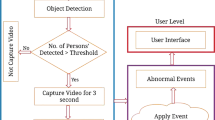Abstract
Automated guided vehicles (AGVs) are Internet of Things robots that navigate automatically as guided by a central control platform with distributed intelligence. Different methodologies have been proposed for AGV visual tracking applications. However, vision-based tracking in AGVs usually confronts the problem of time delay caused by the complexity of image processing algorithms. To balance the trade-off among algorithm complexity, hardware cost and performance, precision and robustness are usually compromised in practical deployment. This paper proposes a prototype design of a visual tracking system. Edge computing is implemented which migrates computation intensive image processing to a local computer. The Raspberry Pi-based AGV captures the real-time image through the camera, sends the images to the computer and receives the processing results through the WiFi link. An improved Camshift algorithm is developed and implemented. Based on this algorithm, the AGV can make convergent prediction of the pixels in the target area after the first detection of the object. Relative coordinates of the target can be located more accurately in less time. As tested in the experiments, the system architecture and new algorithm lead to reduced hardware cost, less time delay, improved robustness and higher accuracy in tracking.






Similar content being viewed by others
References
Bostel AJ, Sagar VK (1996) Dynamic control systems for AGVs. Comput Control Eng J 7(4):169–176. https://doi.org/10.1049/cce:19960403
Fredrik J. Ericsson Mobility Report, Available online: https://www.ericsson.com/4acd7e/assets/local/mobility-report/documents/2019/emr-november-2019.pdf Accessed on 16th April, 2021
Arnold WMS, Dung MC, Rita C, Simone C, Afshin D, Mubarak S (2014) Visual tracking: an experimental survey. IEEE Trans Pattern Anal Mach Intell 36(7):1442–1468. https://doi.org/10.1109/TPAMI.2013.230
Comaniciu D, Ramesh V (2000) Mean shift and optimal prediction for efficient object tracking. IEEE International Conference on Image Processing. Los Alamitos, CA Page(s) 70 – 73
Mahnaz JD, Rahebe NA (2011) Moving object tracking based on mean shift algorithm and features fusion. International Symposium on Artificial Intelligence and Signal Processing (AISP) Page(s) 48 – 53. DOI: https://doi.org/10.1109/AISP.2011.596098
Xiu C, Su X, Pan X (2018) Improved target tracking algorithm based on Camshift. Chinese Control and Decision Conference (CCDC). Shenyang, China. 9-11 June
Mahnaz JD, Rahebe NA (2011) Moving object tracking based on mean shift algorithm and features fusion. International Symposium on Artificial Intelligence and Signal Processing (AISP). Tehran, Iran 15-16 June 2011
Guan W, Liu Z, Wen S, Xie H, Zhang X (2019) Visible Light Dynamic Positioning Method Using Improved Camshift-Kalman algorithm. IEEE Photon J. https://doi.org/10.1109/JPHOT.2019.2944080
Mark V (2008) Bright future for AGVs. Eng Technol 3(11):48–50. https://doi.org/10.1049/et:20081105
Raspberry Pi Hardware. Available online: https://www.raspberrypi.org/documentation/hardware/raspberrypi/README.md Accessed on 16th April, 2021
Yin L, Wang F, Han S, Li Y, Sun H, Lu Q, Yang C, Wang Q (2016) Application of drive circuit based on L298N in direct current motor speed control system. International Symposium on Optoelectronic Technology and Application. Beijing, China 9-11 May
Ultrasonic Ranging Module HC - SR04. Available online: https://www.docin.com/p-908394633.html Accessed on 16th April, 2021
Porambage P, Okwuibe J, Liyanage M, Ylianttila M, Taleb T (2018) Survey on multi-access edge computing for internet of things realization. IEEE Commun Surv Tutor 20(4):2961–2991. https://doi.org/10.1109/COMST.2018.2849509
Chen B, Wan J, Celesti A, Li D, Abbas H, Zhang Q (2018) Edge computing in IoT-based manufacturing. IEEE Commun Mag 56:103–109. https://doi.org/10.1109/MCOM.2018.1701231
Shukla AK, Kahlon GS, Dubey M (2016) UDP LITE: Efficient model for video transmission by UDP lite protocol. 2016 International Conference on Advanced Communication Control and Computing Technologies (ICACCCT), Ramanathapuram, India 25-27 May
Zhai Z, Xiang K, Zhao L, Cheng B, Qian J, Wu J (2020) IoT-RECSM—Resource-constrained smart service migration framework for IoT edge computing environment. Sensors 20(8):1–15. https://doi.org/10.3390/s20082294
Deilamani MJ, Asli RN (2011) Moving object tracking based on mean shift algorithm and features fusion, Artificial Intelligence and Signal Processing, Tehran, Germany. 15-16 June
Guo B, Feng X (2012) Color target tracking strategy in binocular stereo vision based on Camshift algorithm. 24th Chinese Control and Decision Conference (CCDC). Taiyuan, China 23-25 May
Gonzalez RC, Woods RE (2007) Digital image processing, 3rd edn. Pearson/Prentice Hall, Upper Saddle River
Guan W, Liu Z, Wen S, Xie H, Zhang X (2019) Visible light dynamic positioning method using improved Camshift-Kalman algorithm. IEEE Photon J. https://doi.org/10.1109/JPHOT.2019.2944080
Mahnaz JD, Rahebe NA (2011) Moving object tracking based on mean shift algorithm and features fusion. International Symposium on Artificial Intelligence and Signal Processing (AISP). Tehran, Iran. 15-16 June
Hu K, Fan E, Ye J, Pi J, Zhao L, Shen S (2018) Element-weighted neutrosophic correlation coefficient and its application in improving Camshift tracker in RGBD video. Information (MDPI) 9:126. https://doi.org/10.3390/info9050126
Huang M, Guan W, Fan Z, Chen Z, Li J, Chen B (2018) Improved target signal source tracking and extraction method based on outdoor visible light communication using a Cam-Shift algorithm and Kalman filter. Sensors (MDPI). https://doi.org/10.3390/s18124173
Woods J, Radewan C (1977) Kalman filtering in two dimensions. IEEE Trans Inf Theory. 23(4):473–482. https://doi.org/10.1109/TIT.1977.1055750
Groves PD (2008) Principles of gnss inertial and multi-sensor integrated navigation systems. Artech House, Norwood
Welch G, Bishop G (2021) An introduction to the Kalman filter. [Online] Available at: https://www.cs.unc.edu/~welch/media/pdf/kalman_intro.pdf Accessed on 16th April, 2021
Funding
This research was funded by Research Enhancement Fund of XJTLU (REF-19-01-04), National Natural Science Foundation of China (NSFC) (Grant No. 61501380), and by AI University Research Center (AI-URC) and XJTLU Laboratory for Intelligent Computation and Financial Technology through XJTLU Key Programme Special Fund (KSF-P-02).
Author information
Authors and Affiliations
Corresponding author
Additional information
Publisher's Note
Springer Nature remains neutral with regard to jurisdictional claims in published maps and institutional affiliations.
Rights and permissions
About this article
Cite this article
Zhang, T., Nie, X., Zhu, X. et al. Improved Camshift Algorithm in AGV Vision-based Tracking with Edge Computing. J Supercomput 78, 2709–2723 (2022). https://doi.org/10.1007/s11227-021-03974-3
Accepted:
Published:
Issue Date:
DOI: https://doi.org/10.1007/s11227-021-03974-3




